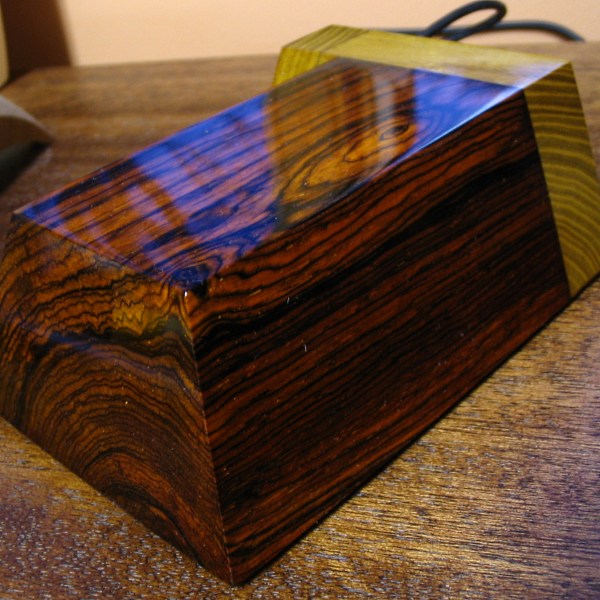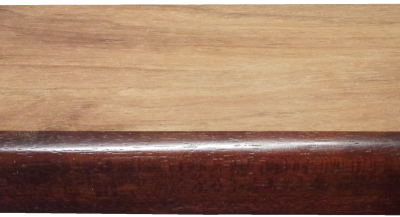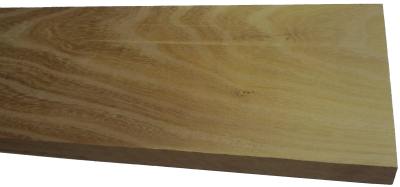When attempting to identify a wood sample, it’s important to keep in mind the limitations and obstacles that are present in our task. Before starting, please have a look at The Truth Behind Wood Identification to approach the task in a proper mindset; I consider the linked article to be required reading for all those visiting my site with the intent of identifying wood.
1. CONFIRM IT IS ACTUALLY SOLID WOOD.
Before proceeding too much farther into the remaining steps, it’s first necessary to confirm that the material in question is actually a solid piece of wood, and not a mn-made composite or piece of plastic made to imitate wood.

CAN YOU SEE THE END-GRAIN?
Manufactured wood such as MDF, OSB, and particleboard all have a distinct look that is—in nearly all cases—easily distinguishable from the endgrain of real wood. Look for growth rings—formed by the yearly growth of a tree—which will be a dead-giveaway that the wood sample in question is a solid, genuine chunk of wood taken from a tree.
IS IT VENEERED?
If you see a large panel that has a repeating grain pattern, it may be a veneer. In such cases, a very thin layer of real wood is peeled from a tree and attached to a substrate; sometimes the veneer can be one continuous repeating piece because it is rotary-sliced to shave off the veneer layer as the tree trunk is spun by machines. Assuming it is a real wood veneer with a distinct grain and texture—and not merely a piece of printed plastic—you may still be able to identify the outer veneer wood in question, but you should still realize that is it only a veneer and not a solid piece of wood.
IS IT PAINTED OR PRINTED TO LOOK LIKE WOOD?
Many times, especially on medium to large-sized flat panels for furniture, a piece of particleboard or MDF is either laminated with a piece of wood-colored plastic, or simply painted to look like wood grain. Many of today’s interior hardwood flooring planks are good examples of these pseudo-wood products: they are essentially a man-made material made of sawdust, glues, resins, and durable plastics.
2. LOOK AT THE COLOR.
Some questions to immediately ask yourself:
IS THE COLOR OF THE WOOD NATURAL, OR IS IT STAINED?
If there is even a chance that the color isn’t natural, the odds are increased that the entire effort of identifying the wood will be in vain.

IS IT WEATHERED OR HAVE A PATINA?
Many woods, when left outside in the elements, tend to turn a bland gray color. Also, even interior wood also takes on a patina as it ages: some woods get darker, or redder, and some even get lighter or lose their color; but for the most part, wood tends to darken with age.

IS IT POSSIBLE TO SAND OR PLANE THE BOARD TO SEE THE NATURAL RAW COLOR OF THE WOOD?
The most predictable baseline to use when identifying wood is in a freshly sanded state. This eliminates the chances of a stain or natural aging skewing the color diagnosis of the wood.
3. OBSERVE THE WOOD GRAIN.
If the wood is unfinished, then look at the texture of the grain. Ask yourself these questions:
DOES THE WOOD HAVE AN OPEN, POROUS TEXTURE?
Most softwoods will be almost perfectly smooth with no grain indentations, while many common hardwoods have an open pore structure, such as oak or mahogany; though there are some hardwoods that are also smooth to the touch, such as maple.
CAN YOU TELL IF THE WOOD IS QUARTERSAWN OR PLAINSAWN?
By observing the grain patterns, many times you can tell how the board was cut from the tree. Some wood species have dramatically different grain patterns from plainsawn to quartersawn surfaces. For instance, on their quartersawn surfaces, lacewood has large lace patterns, oak has flecks, and maple has the characteristic “butcher block” appearance.
IS THERE ANY FIGURE OR UNUSUAL CHARACTERISTICS, SUCH AS SAPWOOD, CURLY OR WILD GRAIN, BURL/KNOTS, ETC.?
Some species of wood have figure that is much more common than in other species: for example, curly figure is fairly common in soft maple, and the curls are usually well-pronounced and close together. Yet when birch or cherry has a curly grain, it is more often much less pronounced, and the curls are spaced farther apart.

